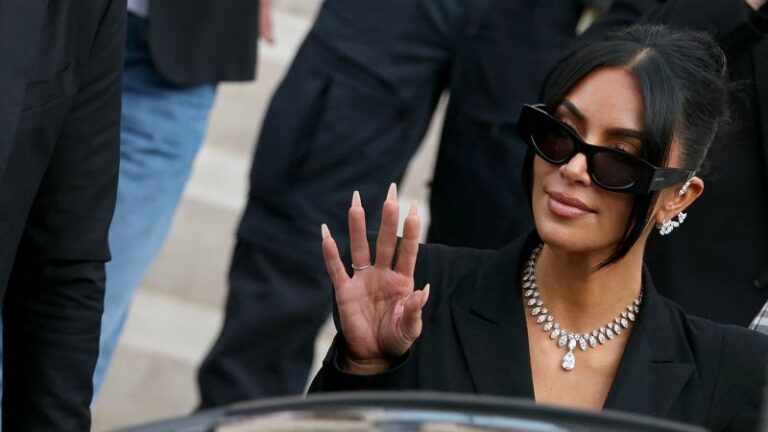CNN
—
Kim Kardashian arrived at the courthouse in central Paris earlier this month composed, collected, and dripping in an estimated $8 million worth of jewelry. The ensemble was a bold choice, considering she was appearing at her own robbery trial, over one of the most audacious celebrity heists in modern history.
She arrived alongside her mother Kris Jenner to testify against the so-called “grandpa robbers” (some suspects in their 60s and 70s, one of which died before the case went to trial, while another developed Alzheimer’s and was deemed unfit to stand), who are facing charges for armed robbery, kidnapping and conspiracy after allegedly stealing $10 million worth of cash and jewelry from the A-lister, who was held at gunpoint, during a trip to Paris in October 2016.
At the trial, Kardashian was bespectacled in Alaïa sunglasses, her form accentuated in a vintage John Galliano black skirt-suit with a plunging neckline and sizeable side-slit. Kardashian’s neck alone was encircled with over 52 carats — courtesy of a tear-drop-shaped necklace from Samer Halimeh — which she paired with diamond earrings, a 4.55 carat Repossi diamond over-the-ear cuff and a white gold and diamond pavé version by Briony Raymond.

The striking Halimeh piece felt like a revenge necklace signalling Kardashian’s unique ability to easily replace millions of dollars’ worth of precious jewels. To some on social media, this served as a gauché reminder of seemingly bottomless wealth. But for NYU fashion law professor and “The Laws of Style” author Douglas Hand, it was a symbol of defiance.
“Her choice of jewelry really underscored the fact that she wants to announce that she’s reclaiming her power after this traumatic event,” Hand told CNN over the phone. “If I were advising her from both a business perspective and a legal perspective, I think you’d want to signal that you are a survivor.”

The power of a carefully considered courtroom outfit should never be underestimated. In 2023, when Gwyneth Paltrow was taken to court for a personal injury claim over a skiing accident, she wore a series of understated, luxurious looks — including a loden coat from The Row, pants by Proenza Schouler, boots by Celine and a number of her own branded sweaters — that swayed the online demographic in her favor. Several fans took to social media to rate her looks out of ten, while some even sought to recreate them at home.
What could have easily become a brand-damaging episode — Paltrow’s expensive taste in ski instructors and her decision to have a post-crash massage were key elements of the prosecution — surprisingly became a masterclass in the soft power of fashion. Ultimately, the jury unanimously sided with Paltrow and found her not liable.
Similarly, when author E. Jean Carroll appeared in court to testify against US President Trump in 2023, accusing him of sexually abusing her in a Bergdorf Goodman store in 1996, the writer curated a series of decorous earth-toned tailored dresses, smart jackets and off-white overcoats, which presented her as the antithesis of the “whack job” Trump had tried to label her. Despite denying the allegations and publicly insulting Carroll for making the claim, Trump was found liable for sexual assault battery and Carroll received $5 million in damages. (A year later, she was awarded another $83.3 million for defamation.)
Elsewhere, celebrities including Megan Thee Stallion and Cardi B have enlisted their regular red carpet stylists to help create courtroom looks that still feel authentic to them: sharp tailored suits (worn shirtless, however) with hair cut into razor-sharp bobs.
According to Hand, the consideration that goes into courtroom clothes isn’t merely an exercise in vanity. “(These outfits) are pretty choreographed by any well-advised litigant,” he said. “For high profile litigants, courtroom dress is usually an attempt to dispel any appearance of wrongdoing, whether you’re charged with a crime or you’re embroiled in some dispute or a nasty divorce.”
The right ensemble can also help promise “some degree of credibility,” added Hand. This seems to be the strategy of music mogul Sean “Diddy” Combs, who during his ongoing trial on federal charges of sex trafficking and racketeering has avoided all iterations of masculine power-suiting and instead opted for soft sweaters, glasses and undyed grey hair. The result, some argue, is a curated image that seems like a far cry from the alleged crimes. “Your apparel choices speak before you do,” Hand added. “That’s incredibly important, particularly in a high stakes situation like a court of law.”
For almost as long as celebrities have been breaking the law, they have at least been dressing for the occasion. In 2002, Winona Ryder arrived at her shoplifting trial (she was accused of stealing more than $5,500 of designer goods from Saks Fifth Avenue) dressed in a Marc Jacobs trompe l’oeil knit dress that has since gone down in fashion history. Her sartorial strategy was clear: midi-skirts and dresses that were elegant, prim and demure, worn with headbands for a youthful earnestness.
“How nice to see a defendant rise above the tried-and-true dark suit and opt for a more fashionable facade,” wrote Robin Givhan at the time, in a tongue-in-cheek report for the Washington Post. Unfortunately, no matter how much her hemline communicated sweetness and light, Ryder was still found guilty and sentenced to 480 hours of community service, a $3,700 fine and 36 months of probation.
When rapper Lil’ Kim was on trial for perjury in 2004, she coordinated her tailored pinstripe suit vest and slacks with those worn by her attorney Mel Sachs. In fact, several of her courtroom looks were reportedly personally gifted by Marc Jacobs — a close friend of the musician — who provided her with modest sandy-colored suits and bouclé twin-sets.
But too heavy an emphasis on fashion can also backfire. When Martha Stewart was brought to trial for insider trading in 2004, her choice to wear a mink stole and chestnut-colored Hermés Birkin bag sparked controversy. “The Birkin did little to promote the image of an approachable woman who has struggled up from humble roots,” wrote the New York Times that same year. “Instead, it cemented an image of her as a pampered fat cat seemingly willing to snatch money from an Average Joe Stockholder.”
Meanwhile, when Michael Jackson arrived at court in 2005 after being accused of child molestation (he was later acquitted), the pop star showed up dressed in flamboyant brocaded vests and dazzling waistcoat jewelry — much like what he wore on stage. Ideally, said Hand, celebrities want to aim for a “sober” outfit that feels “conservative to emphasize trustworthiness.” Anything else risks sending a message of flagrance, which can sour jurors fast.
Earlier this year, the realms of fashion and law enforcement intertwined even further when rapper A$AP Rocky appeared in a Los Angeles court facing charges of two counts of felony assault, one with a firearm. Rocky, who recently co-chaired the 2025 Met Gala, arrived at his trial looking strikingly dapper. His gabardine trench coat, wool chiné pants and striped satin shirt worn with sunglasses was a sophisticated, stylish take on courtroom dressing. Upon first glance, it looked like the type of paparazzi-style campaign Rocky has starred in for Italian luxury label Bottega Veneta. A few days later, a press blast distributed to journalists confirmed that Rocky had been kitted out head-to-toe in Saint Laurent.
When the media alert was sent, Rocky — who has now been acquitted on all charges — was still the lead suspect in an ongoing criminal trial. But Saint Laurent was not deterred by the questionable backdrop, continuing to send multiple releases after each new courtroom appearance. It surprised even a senior fashion public relations executive in London, who said they would advise PRs to avoid sharing outfit details and shopping links when pieces have been worn to sensitive events. “It’s not appropriate to be shouting about them wearing your brand in those contexts,” they said. “It’s tacky.” (Saint Laurent did not respond to requests from CNN for comment.)
But the French luxury house isn’t the only brand hoping to captialize on the free press that comes with highly publicized lawsuits. In 2024, Anna Delvey — the “fake heiress” who was found guilty of grand larceny, among other financial crimes, in 2019 — used one of her immigration court appearances to promote emerging fashion label Shao New York by wearing a custom outfit by the brand (the designer is a client of the OutLaw Agency, a venture Delvey began with publicisit Kelly Cutrone in 2023).
In Kardashian’s case, she was not appearing as a person convicted of a crime but rather a veritable victim. “The appearance of wrongdoing was not anything that she needed to address,” said Hand. Instead of sending a message to the judge and jury, as is usually the goal of a celebrity courtroom outfit, Kardashian’s diamonds spoke directly to the public. What they were really intended to say, however, isn’t crystal clear.








